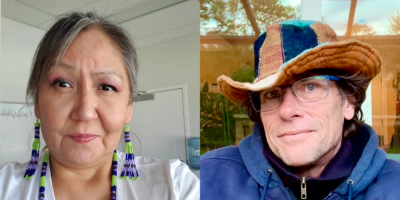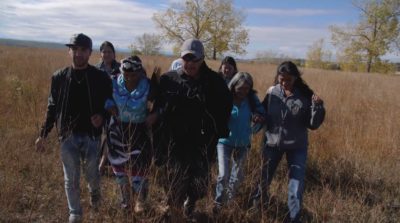Strong Medicine: Seven years later

In 2018, CATIE and CAAN (Communities, Alliances & Networks) released Strong Medicine, a film by and for Indigenous people living with HIV. The film weaves together Indigenous knowledges of culture and wellness with Western knowledge of HIV testing and treatment. By sharing their experiences with Indigenous and Western medicines, eight Indigenous activists teach us that HIV isn’t something to be feared and show us different ways to walk the healing path.
Seven years after Strong Medicine was released, CATIE spoke with two of its stars, Danita Wahpoosewyan and Trevor Stratton, to reflect on what has changed, what has remained the same, and what people can do to keep sharing the film’s important message.
Why is Strong Medicine powerful?
At its heart, Strong Medicine celebrates life. It teaches about testing, diagnosis, treatment and care by showing what a good life with HIV can look like. The film opens up possibilities for Indigenous people to know themselves, help others and strengthen their spirit. Many Indigenous people who have been cut off from their culture are searching for their identity and community. For Danita, reconnecting with her culture was the start of her healing journey. “If everyone has the opportunity to search for who they are and learn more about the gifts Creator gave them, they are going to be so empowered and feel good about themselves.”
The film also shows the power of wholistic health and what it means to live in harmony with oneself and others. “We are connected to everything in the universe. Every grain of sand and every star is our relative,” says Trevor. In Western medicine, this interconnectedness is now referred to as One Health, something that Indigenous science has long known. Strong Medicine teaches this concept by showing us that wellness is interconnected with our relationship to the land and with all our relatives who walk, fly, crawl and swim.

What has gotten better since Strong Medicine was released?
In the last seven years, there have been many advances in HIV prevention, testing and treatment. There are more prevention options than ever before, including new options to prevent other STIs like syphilis, gonorrhea and chlamydia. There are new HIV and STI testing options available in many parts of Canada, making testing more accessible to a wider group of people. HIV treatment has become much simpler and has far fewer side effects.
As understanding increases around the importance of Indigenous ways of programming and research, so too does financial investment and allocation of resources. More healthcare providers are incorporating a trauma-informed lens into their practice. Organizations are increasingly helping people connect with their culture through community engagement, such as healing circles with Elders and Knowledge Keepers, as well as land-based activities like medicine picking and hunting.
There is growing recognition of the importance of Indigenous peer support programs and networks, where a shared sense of community is the frontline of connection and support. Albeit slowly, there is growing recognition that lived experience is equally important as academic knowledge and should be valued as such. There are more opportunities for peers now compared to seven years ago, but there is still a long way to go to achieve true employment equality.
What has gotten worse?
Racism and anti-2SLGBTQI+ discrimination are on the rise. The drug toxicity crisis continues to claim many lives while voices opposed to harm reduction grow louder. As inflation rises and the cost of living becomes more expensive, poverty increases too. An economic crisis worsened the housing shortage, leading to encampments in several parts of Canada.
And above all else, the COVID-19 pandemic made nearly every inequity worse. Access to testing, treatment and health promotion services changed radically in early 2020, with some services ending altogether. The redirection of funding and resources made it hard for many community organizations to keep their doors open and provide the services that their clients relied on.
Despite all the advances in HIV prevention, testing and treatment, many of these are still not reaching people who could benefit the most. Sometimes, options are not offered equally to everyone, while other barriers, such as a lack of access to transportation or childcare, further reduce prevention, testing and treatment options.
What hasn’t changed?
HIV stigma persists and, in some places, thrives. Stigma appears in negative healthcare experiences, creating unsafe spaces and mistrust of healthcare providers, as well as leading to low awareness of prevention, testing and treatment options and driving people away from these life-saving services. Stigma can appear as rejection by kin and community, leaving some Indigenous people living with HIV feeling alone or isolated. This loneliness can be devastating. And where there is stigma, there is fear. Fear can prevent people from starting HIV treatment and reaching an undetectable viral load. Because of stigma and misconceptions, many Indigenous communities have not heard the message of U=U or may not believe the message.
What can people do?
Service providers and community-based organizations can create culturally safe spaces to screen Strong Medicine and increase knowledge about advances in HIV prevention and care, including the message of U=U. Service providers can also advocate for access to new and emerging prevention, testing and treatment options. Education and advocacy can happen through campaigns, workshops, training and community outreach. Furthermore, valuing and sustaining the work of Indigenous peers – people with expert experience – is key to reaching “hard to reach” populations and showing them that they can live well with HIV.
Healthcare providers and clinics should stay up to date on advances in HIV prevention, testing and treatment, and understand what trauma-informed healthcare delivery means, as well as what it looks like in practice. Providers should offer multiple prevention and treatment options to patients, including Indigenous-specific options where available, such as talking to an Elder or visiting a healing lodge. Again, peer programming and support networks are key to helping people connect with these options.
Indigenous communities can share Strong Medicine and use the facilitation guide to spark discussions and encourage learning more about HIV to reduce stigma and shame. Communities can create safe spaces for healing and reconnection that welcome Indigenous people living with HIV back into the circle and screening Strong Medicine is one path to do so.
“One day, I will be an Elder and see grandchildren and great grandchildren,” says Danita. “My health is important for this journey.”
Danita Wahpoosewyan is 58 years young and the proud mother of two children, four grandchildren and four great-grandchildren. She is from Treaty 4, Anishinabek First Nation (formally Sakimay First Nation), and her spirit names are Lightning Rock Woman, She Who Calls Far and White Horse With Wings. She was diagnosed with HIV in 2005 and has been a strong peer leader working with community organizations, researchers and healthcare providers. She received the Sheldon Bowman Memorial Award in 2019 and in 2023, as well as the CAAN Legacy Lifetime Award in 2019.
Trevor Stratton is a citizen of the Mississaugas of the Credit First Nation. Diagnosed with HIV in 1990, Stratton has been a resilient advocate and leader ever since and maintains strong involvement with Two-Spirit and HIV/AIDS communities. He has been part of CAAN Communities, Alliances & Networks, for over 20 years and won the Canadian Association of HIV Research’s Red Ribbon Award in 2019. His local and global efforts have contributed significantly to community mobilization and the broader understanding of HIV and AIDS in Indigenous communities.
